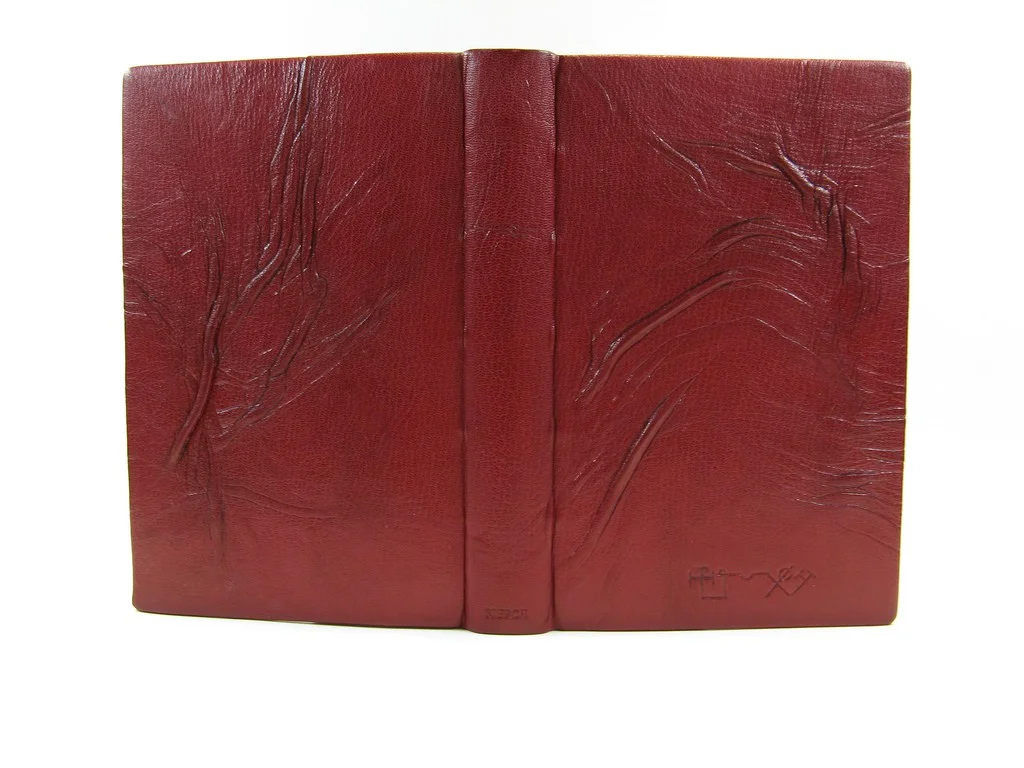

Ambrose Bierce. Bound 2011. Red and grey puckered goatskin, blind tooling,
My first fine binding, done in the french style. I was inspired by a video of Anthony Cains using this technique on a book. As I was still working out how best to pare such a huge piece of leather I thought it would be best to have as little paring as possible. While the binding might be over the top for Bierce's satirical dictionary, it was a very fun binding to do and a technique I have utilized a few times since then.



Daphne Dumaurier - published by the Folio Society 2007. Goatskin, Backpared onlay, blind & gold tooling, handsewn endbands, leather doublures.
Each year at the North Bennet Street School, students in the final year of the bookbinding program are each given a copy of the same text to bind in full leather. This was the book assigned for my year. The titular story in the book is set in Venice, and my obsession for maps led me to create a map of Venice for the design. The canals in blue are all one large backpared onlay of leather.
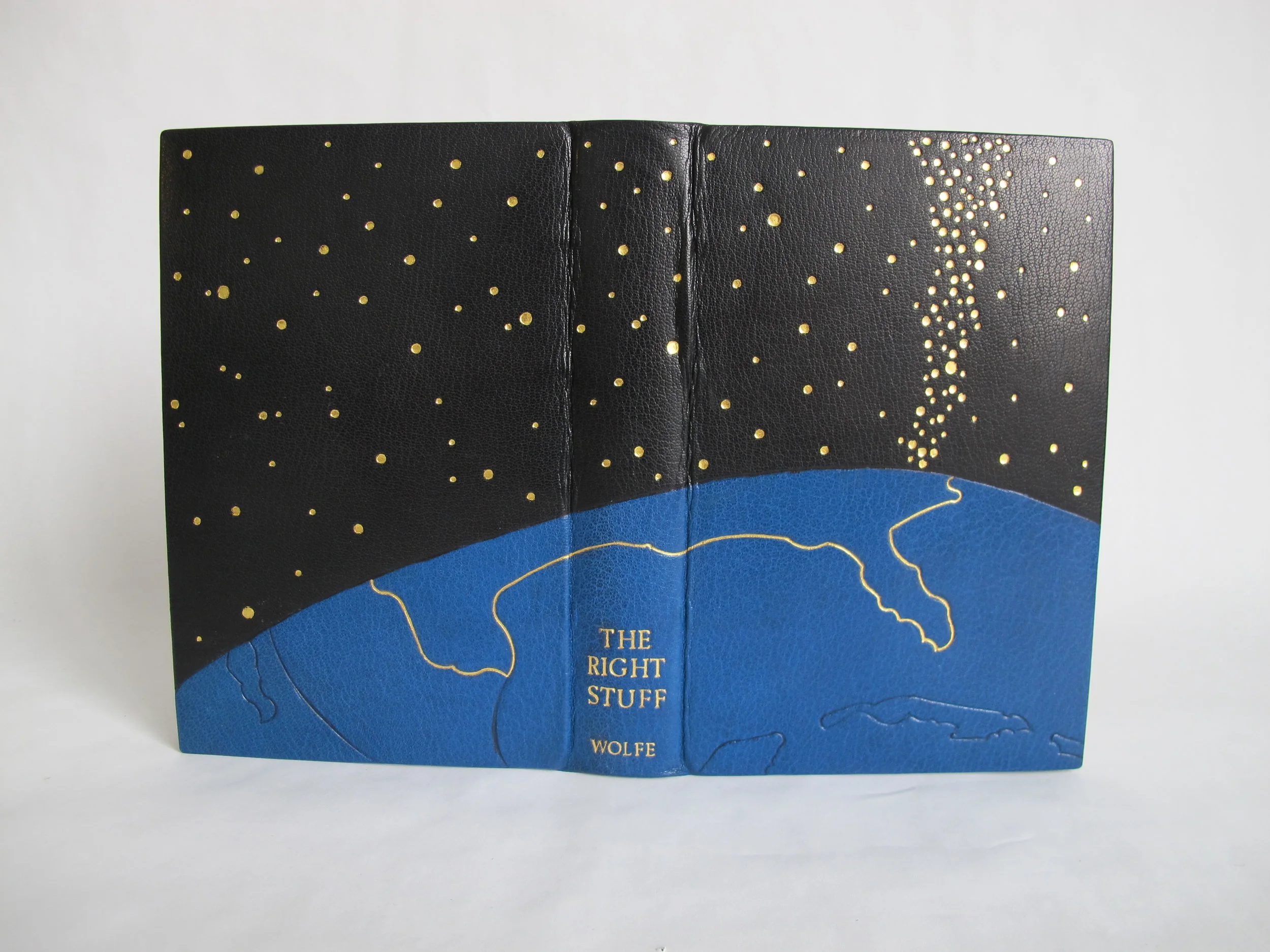

Goatskin, Back Pared Onlay, Blind Tooling, Gold Tooling, Hand Sewn Silk Endbands.
Rebound in 2011 for the One Book, Many Interpretations: Second Edition show in Chicago. As the focus of the book is on the United States, so is the binding, as only the USA is done in gold. The launch site in Florida is the focus of the binding: from there issues a dense concentration of golden stars, meant to evoke both the trail of a rocket and the Milky Way.
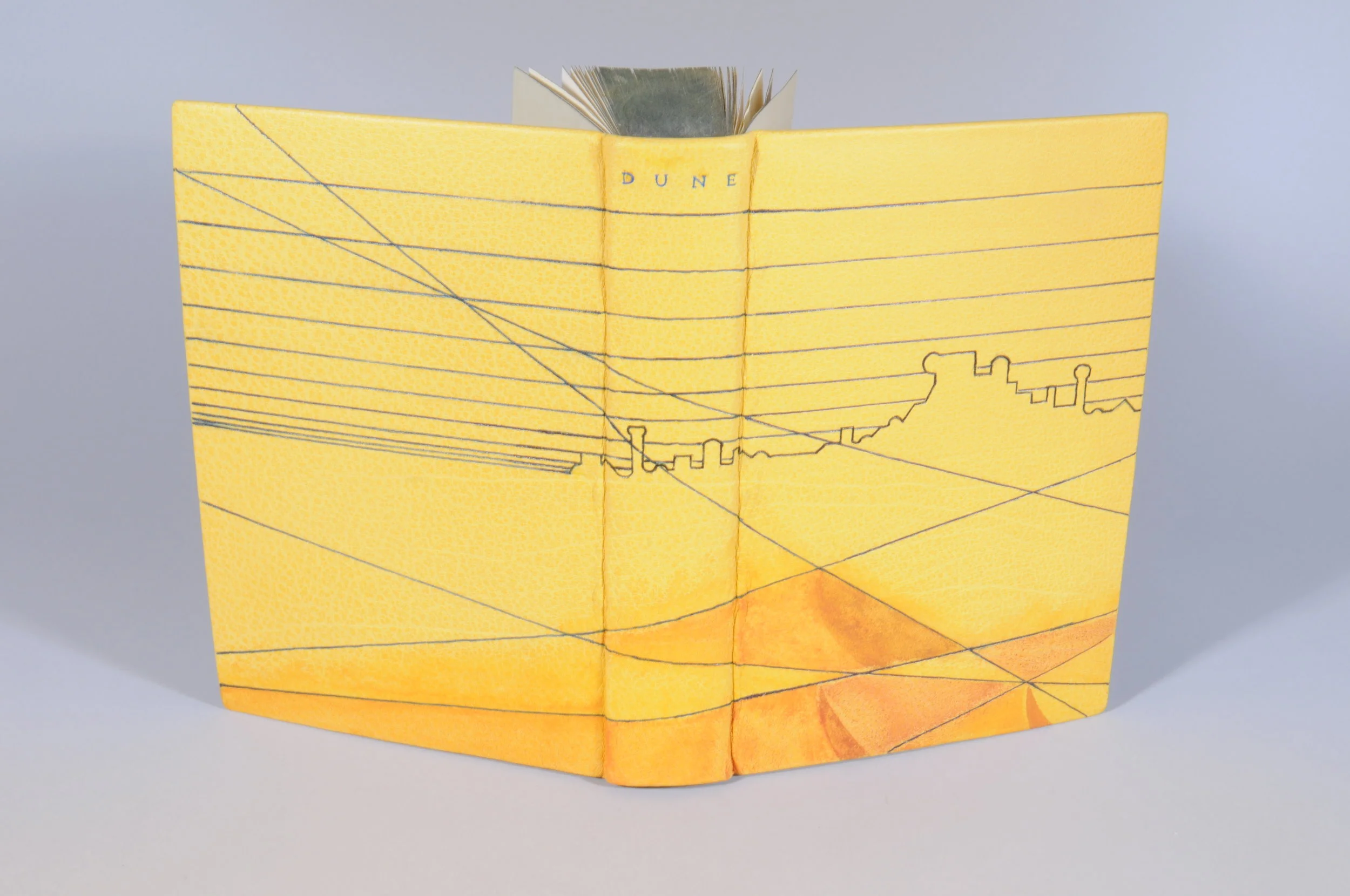

Frank Herbert - 1965. Rebound in 2012. Buffalo skin, blind tooling, acrylic paint, handsewn silk endbands.
The only yellow binding I've ever done, as well as the only one in buffalo skin. The skyline of the capital city of Arrakis is done with various gouges and pieces of line, and all the tooling is filled in with various colors of acrylic paint.
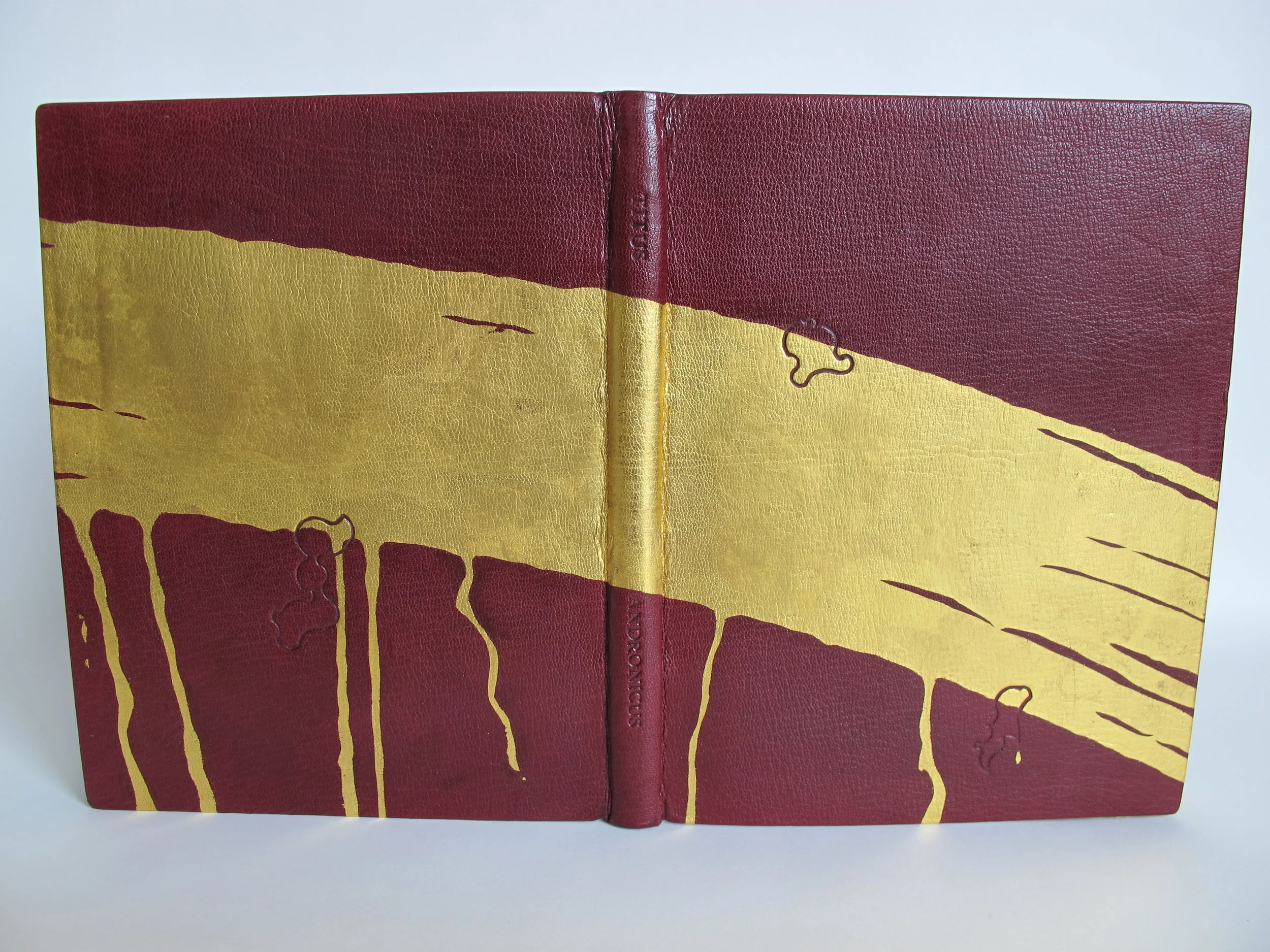
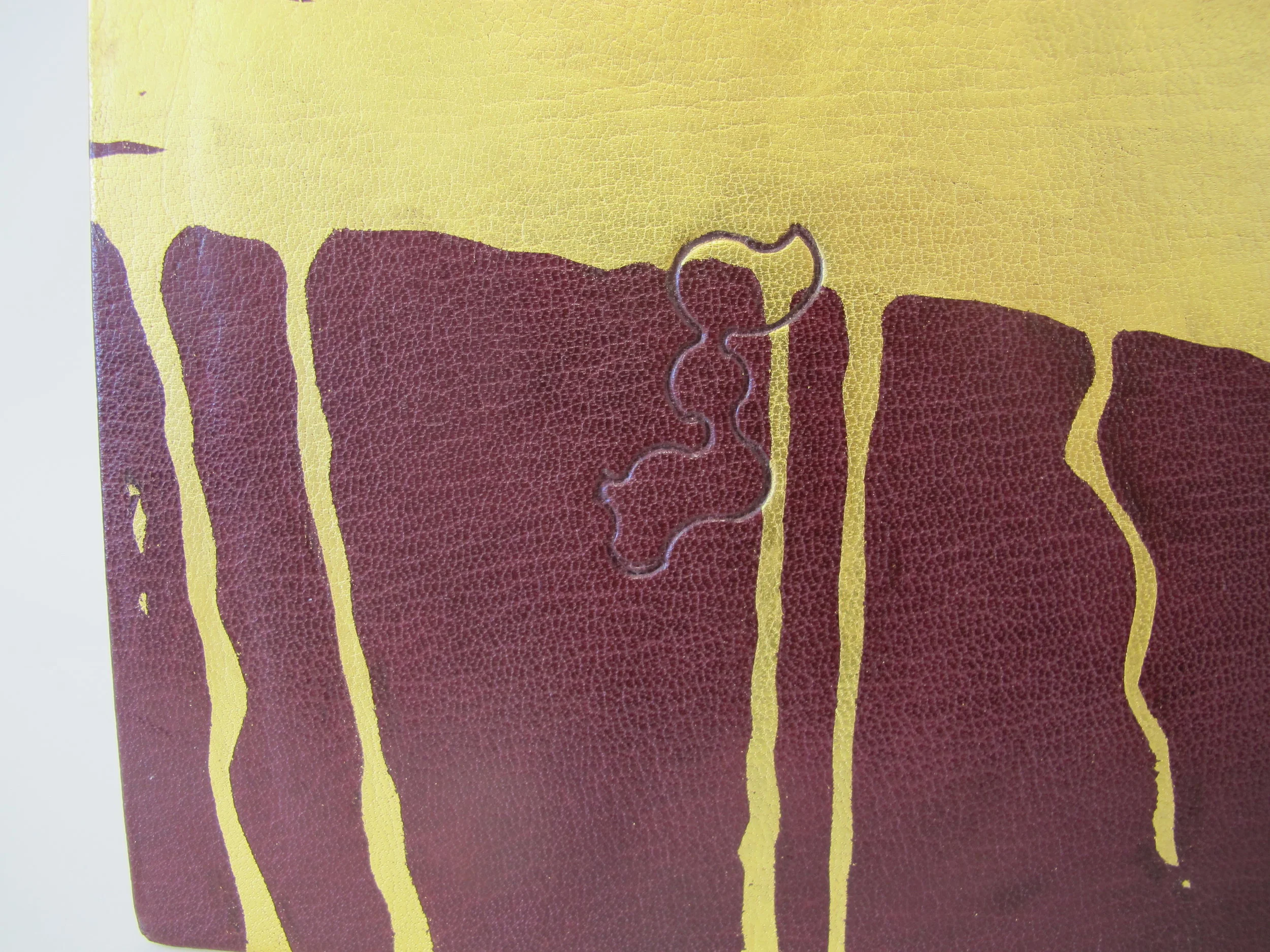

William Shakespeare, with illustrations by Cho Lee and Theoni Aldredge, published by the Folio Society 1970. Rebound 2012. Red Goatskin, Blind tooling, Surface Gilding.
This book was largely an experiment in trying large scale surface gilding. In order to get the design across the spine I had to apply the gold before covering the book with the leather. Titus Andronicus is known as Shakespeare's most violent play, and I wanted to bring the elements of blood and royalty into the design.

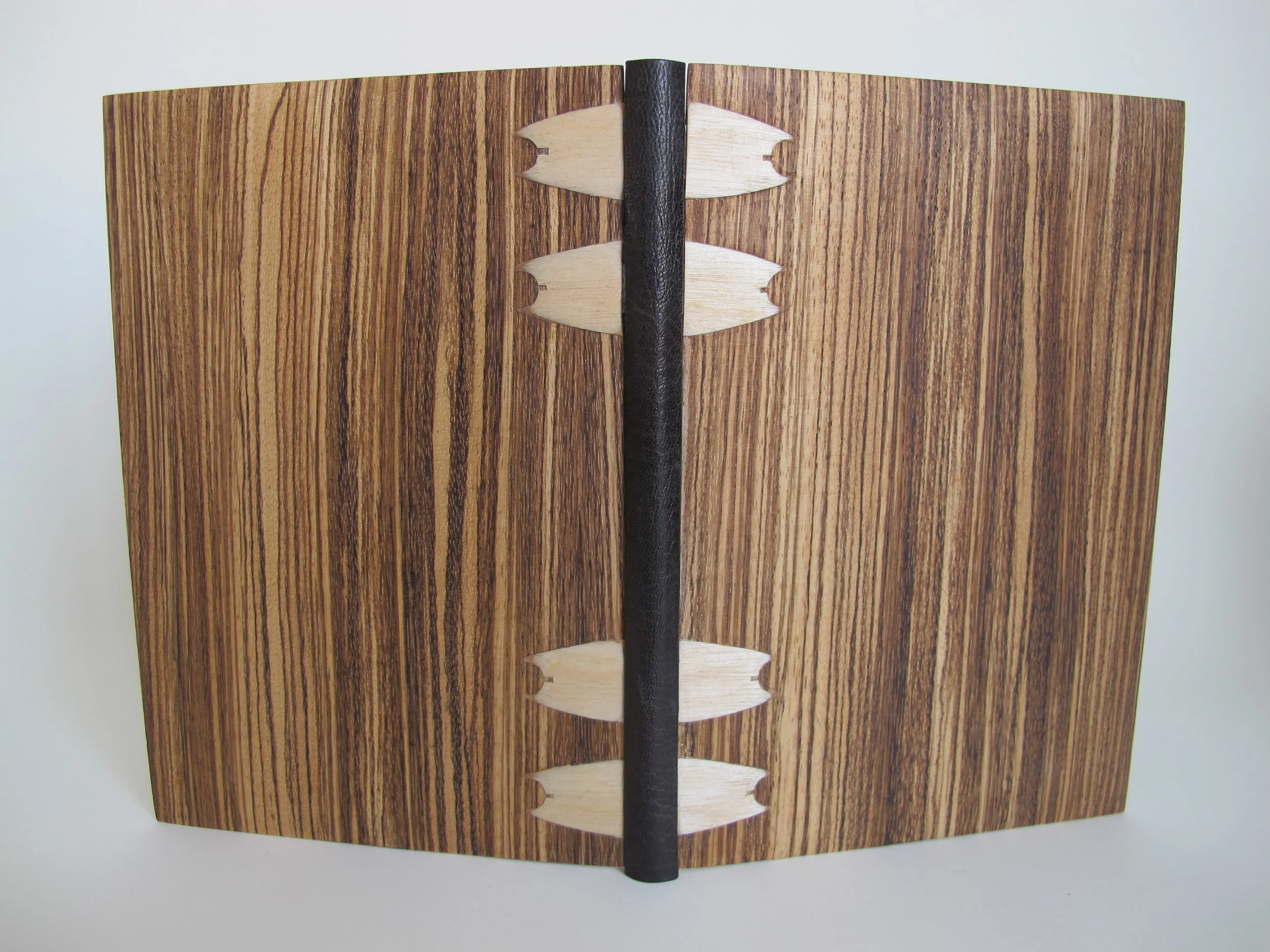
Eric Sloane - 1963. Rebound in 2012. Wood veneer, MDF, snakeskin, goatskin, ultrasuede.
Rebound over a week long workshop with Edgard Claes, I didn't have high hopes for this book. In previous workshops I hadn't come away with very good books, but a lot of practicing to do on the structure I had learned. By the end of the week though, I had come away with a book I was very happy with.
Claes calls this a Dorfner binding after German binder Otto Dorfner who developed the structure in the early 20th century. It is a binding sewn on supports (in this case, watersnake skin laminated to silk) with the boards attached to the textblock only by these sewing supports. The boards are not made of solid wood but medium density fiber board and wood veneer. This allows for the look of wooden boards without worrying about cupping or warping as MDF is dimensionally stable.
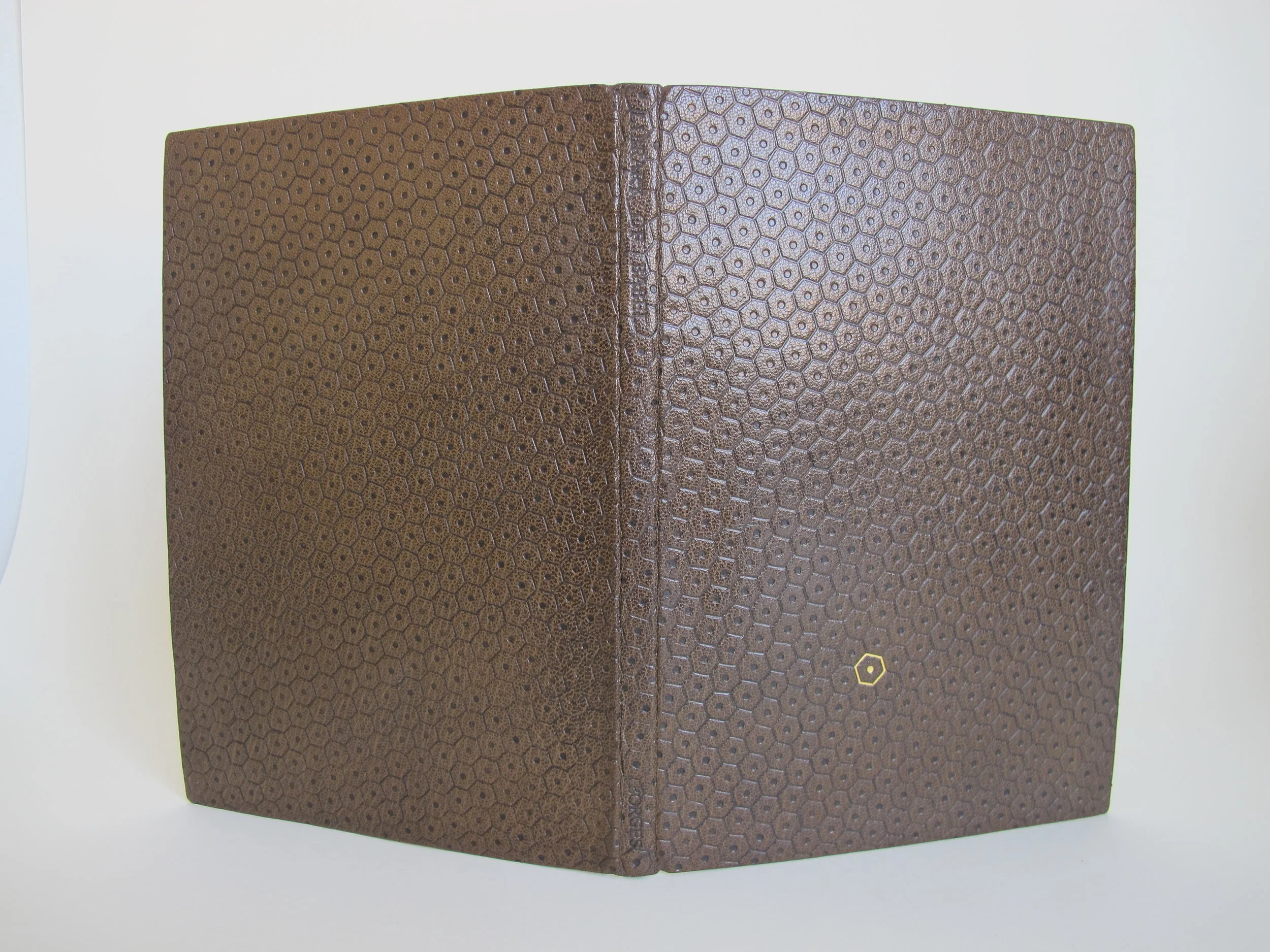
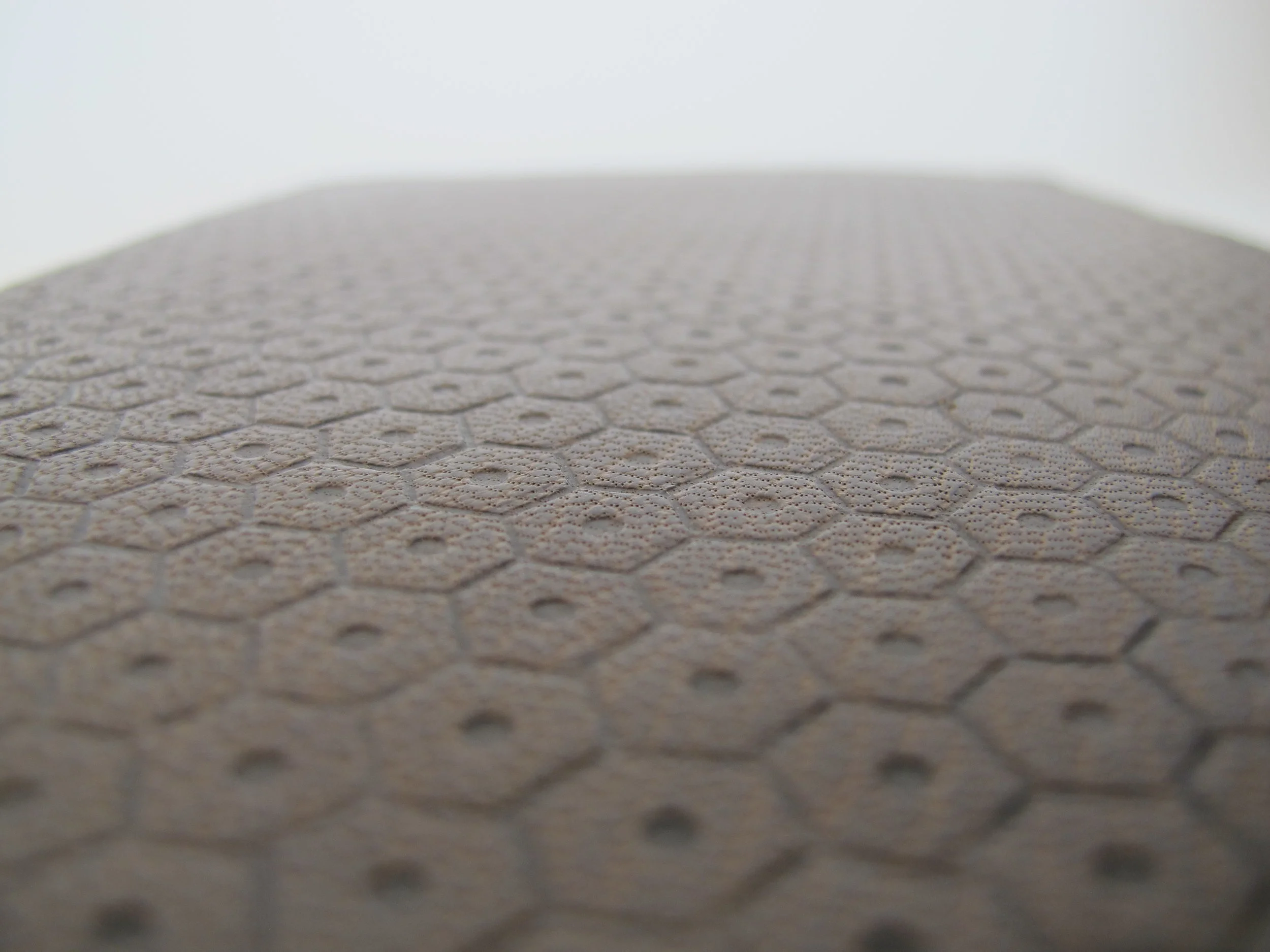

Jorge Luis Borges - published by David Godine in 2000
Goatskin, blind tooling, gold tooling, hand sewn silk endbands.
One of my favorite stories by one of my favorite authors, the Library of Babel describes an infinite library. The design on the book is actually a map of the library. Executed with a single piece of line and a single dot, this binding was an exercise in repetition, but overall a satisfying one.

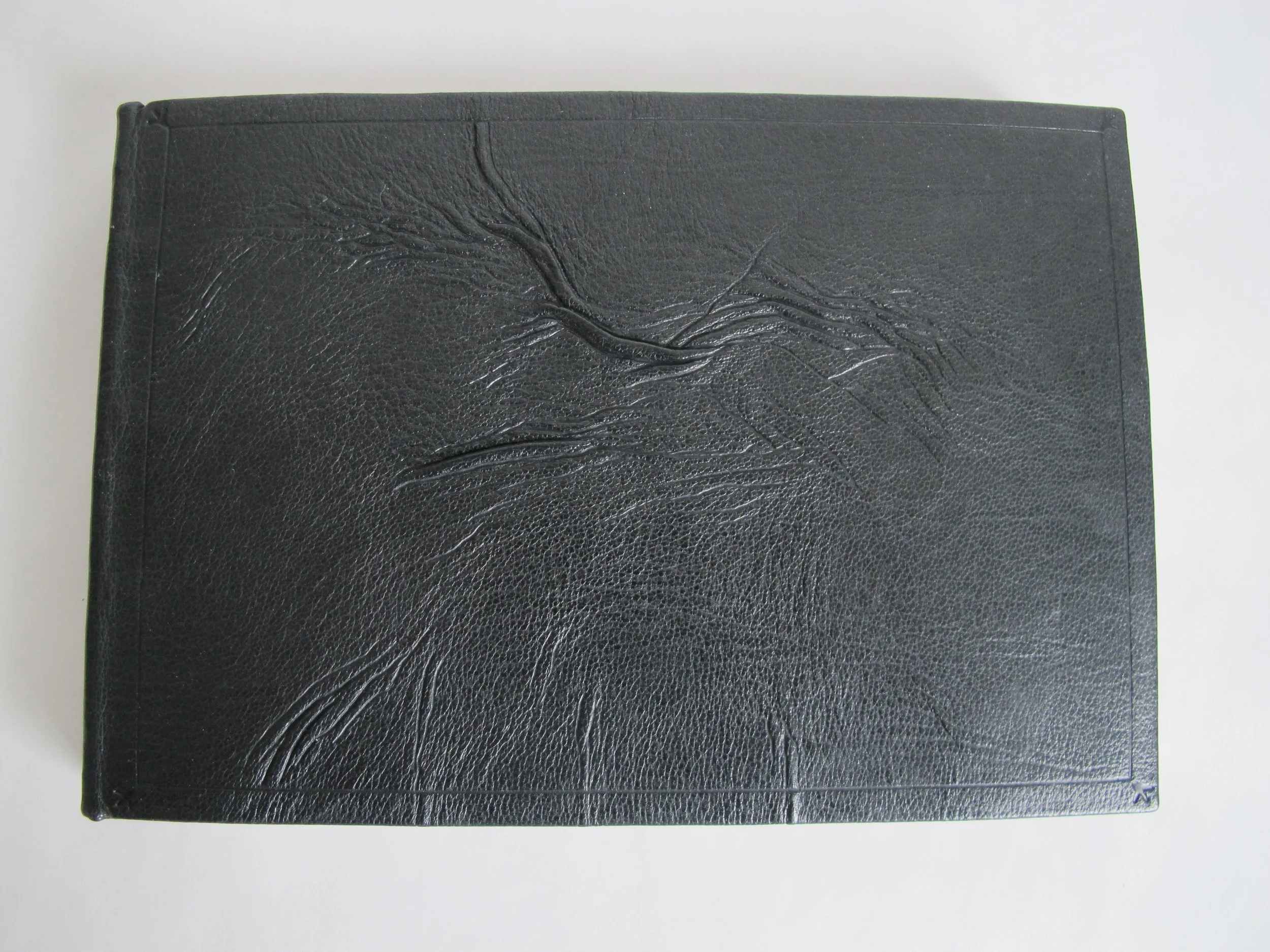
Edgar Allan Poe - 1848, published by Cheloniidae Press 1985. Bound 2014. Puckered Black Goatskin, Blind tooling.
For this book I wanted to make a binding that was appropriately moody for a poem that is such a classic. A nice little touch on this book is the little bird foot tool used in the corners of the design, made by fellow binder Brien Biedler.
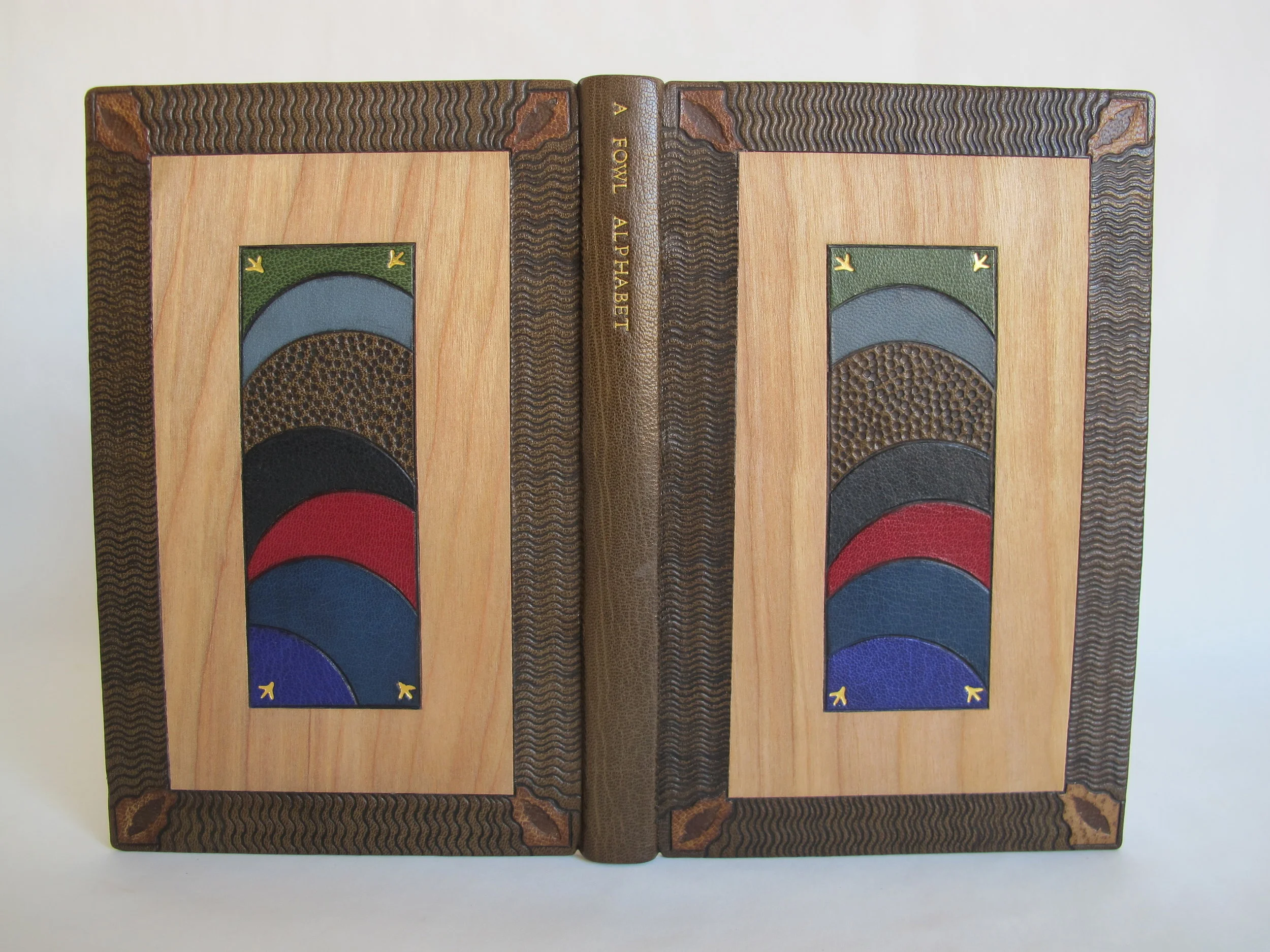

Alan James Robinson, 1986. Bound 2015. Goatksin, White oak veneer, goatskin onlays, hand sewn silk endbands, blind tooling, gold tooling.
When I was working on my bachelor's degree at Hampshire College I was very fortunate to take a course at Smith College's Mortimer Rare Book room with Martin Antonetti. While there I as able to see many books in that collection, a lot of which come from artists living and working in the Pioneer Valley. One of these artists as Alan James Robinson who operated the Cheloniidae Press. I was enchanted with his amazing illustrations. Nearly a decade later I was fortunate enough to buy some books from Alan that had been artists' proofs that he was looking to get rid of. A Fowl Alphabet is one of these.
The design is a result of my fascination with texture. Densely tooled blind lines ring a smooth frame of white oak veneer inlaid into the leather. In the center panel leather are onlays of different colors meant to evoke the sweep of a wing.
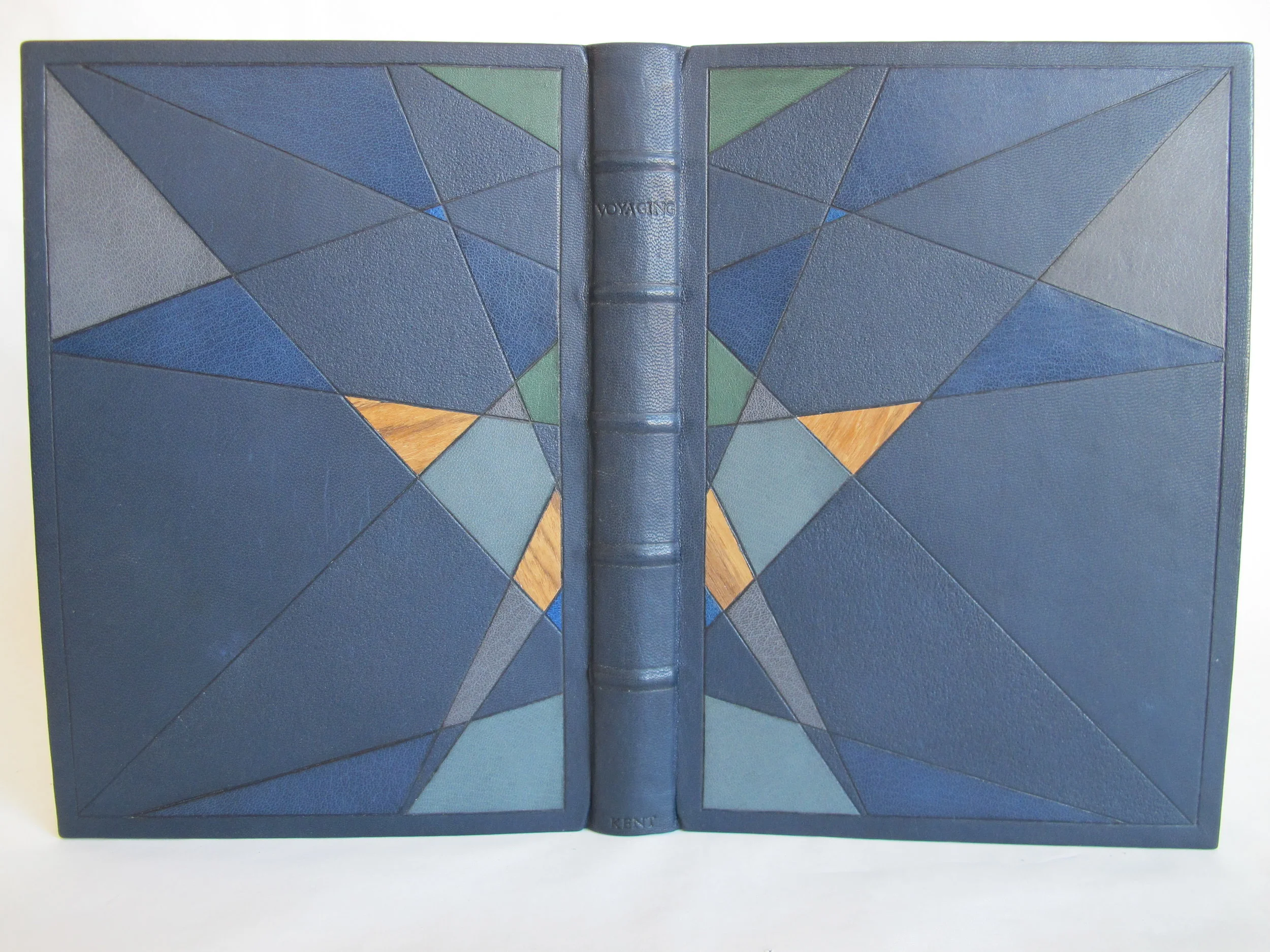


Rockwell Kent - 1924 Bound 2014
Goatskin, blind tooling marbled endpapers, hand sewn silk headbands, various color onlays, teak inlay, grain manipulation.
Kent's account of refitting a boat and the difficult journey he has at the southern tip of South America is beautifully illustrated in his trademark style. The design is meant to evoke both the rigging on a sailboat and the heading lines on older navigational charts. The golden ratio and the book's structure are used to generate the geometry. The leather onlays and grain manipulation are patterned after the changing colors of the ocean, and the wood inlays are teak, a wood used in shipbuilding for millennia.
Goatskin, blind tooling marbled endpapers, hand sewn silk headbands, various color onlays, teak inlay, grain manipulation.




Russell Maret - 2016
325 mm x 235 mm
Goatskin, blind tooling, gold tooling, hand sewn silk endbands.
I was fortunate enough to be able to buy a copy of Russell Maret's book in unbound sheets. The book lacks almost all text, instead consisting of print of Maret's explorations of abstract letterforms. The entirety of the introduction states "A letterform is a spatial disturbance; an act of interference on an otherwise passive grid." For my design this passive grid is tooled in blind on the cover, while lines that are similar to the print for the letter V are tooled in gold.


Alice Cornell - 1997. Bound 2016
66 mm x 54 mm
Silk Endbands, Acrylic Paint, Goatskin, Paper, Stone Veneer, Foil Tooling
The star of Shaman are the prints showcasing the petroglyphs collected from across North America. The design incorporates stone veneer and foil stamping of two of the prints. The uneven application of the foil onto the rough surface of the stone is meant to convey weathering and antiquity. The stone veneer inlay on the doublures are abstract outlines of hands, the tools responsible for making not only the book, but also the ancient petroglyphs.


David Esslemont, published 2002. Bound 2016.
260 mm x 180 mm
Gilt Leather Endbands, Alum Tawed Pigskin, Snakeskin, Brass, Pigskin Parchment, Novasuede, Medium Density Fiberboard, White Oak Veneer.
Bound for the Open Set 2017 competition by the American Academy of Bookbinding, Inside the Book is a modern look at making an ancient object, and so is this binding. The binding structure is from the 20th century, but the materials used are very traditional. Alum tawed pigskin and white oak have been used on books since medieval times, the use of parchment predates the invention of paper, and brass has been traditionally used to make impressions on damp leather. The shape of the brass tabs on the cover are inspired by a bone piece on the Glazier Codex and the small inlaid brass circles are meant to invoke the placement of clasps one might see on the binding of a medieval manuscript.



Geert Mak - 2016. Bound 2017. Goastskin, blind & gold tooling, handsewn endbands.
82 mm x 70 mm
A recollection of squatting on a neglected island in Amsterdam, the author talks about the development and living conditions on a piece of land that has little infrastructure. The one piece of infrastructure that did exist was electrical lines, and the golden lines on the book are meant to evoke those flying across the island while trash and debris piles around and gathers on the ground.





Samuel Crumpe, M.D., published 1793. Rebound 2018.
205 mm x 160 mm
Full leather goatskin binding, onlaid dyed leather, blind tooling, wenge veneer inlays, hand sewn silk endbands, all edges rough gilt, marbled endpapers and pastedowns.
This book had been rebound previously by an amateur binder who had not done the book any favors. I was asked to rebind it in a more suitable container. I opted for a sympathetic cambridge panel style binding. The center panels in this case are dyed leather to bring forth a brighter color like poppy blossoms and add a little bit of a psychedelic feel.


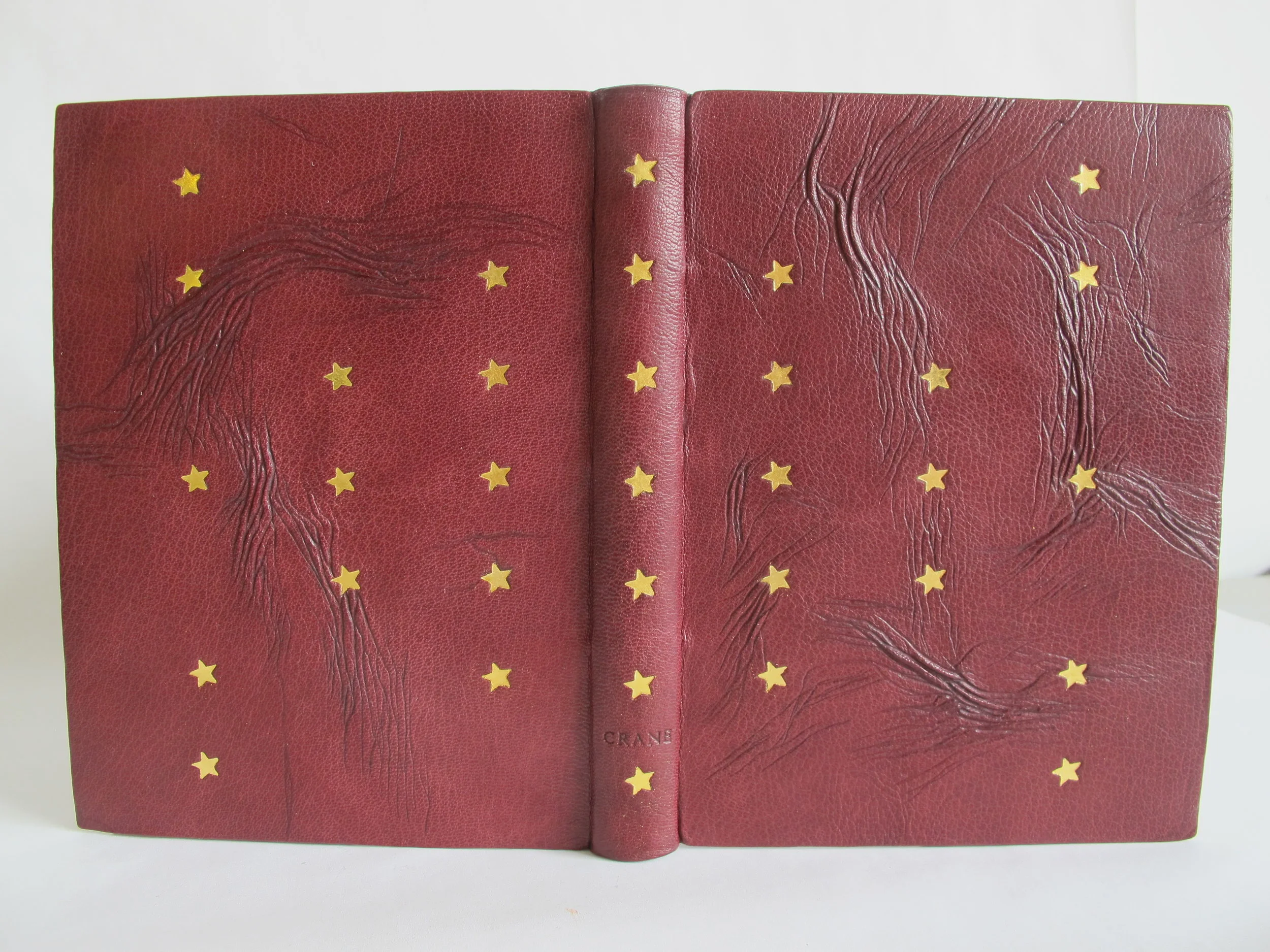
Stephen Crane. Published 1895. Rebound 2018.
205 mm x 170 mm
Puckered goatskin, blind tooling, gold tooling, gilt edges, gilt endbands
I wanted this book to reflect the ugly nature of the Civil War, and I turned to puckered leather, one of my favorite techniques, to do so. I then accentuated the wrinkles with blind tooling. The pattern of the stars is from the Fort Sumter flag where the first shots of the Civil War were fired.


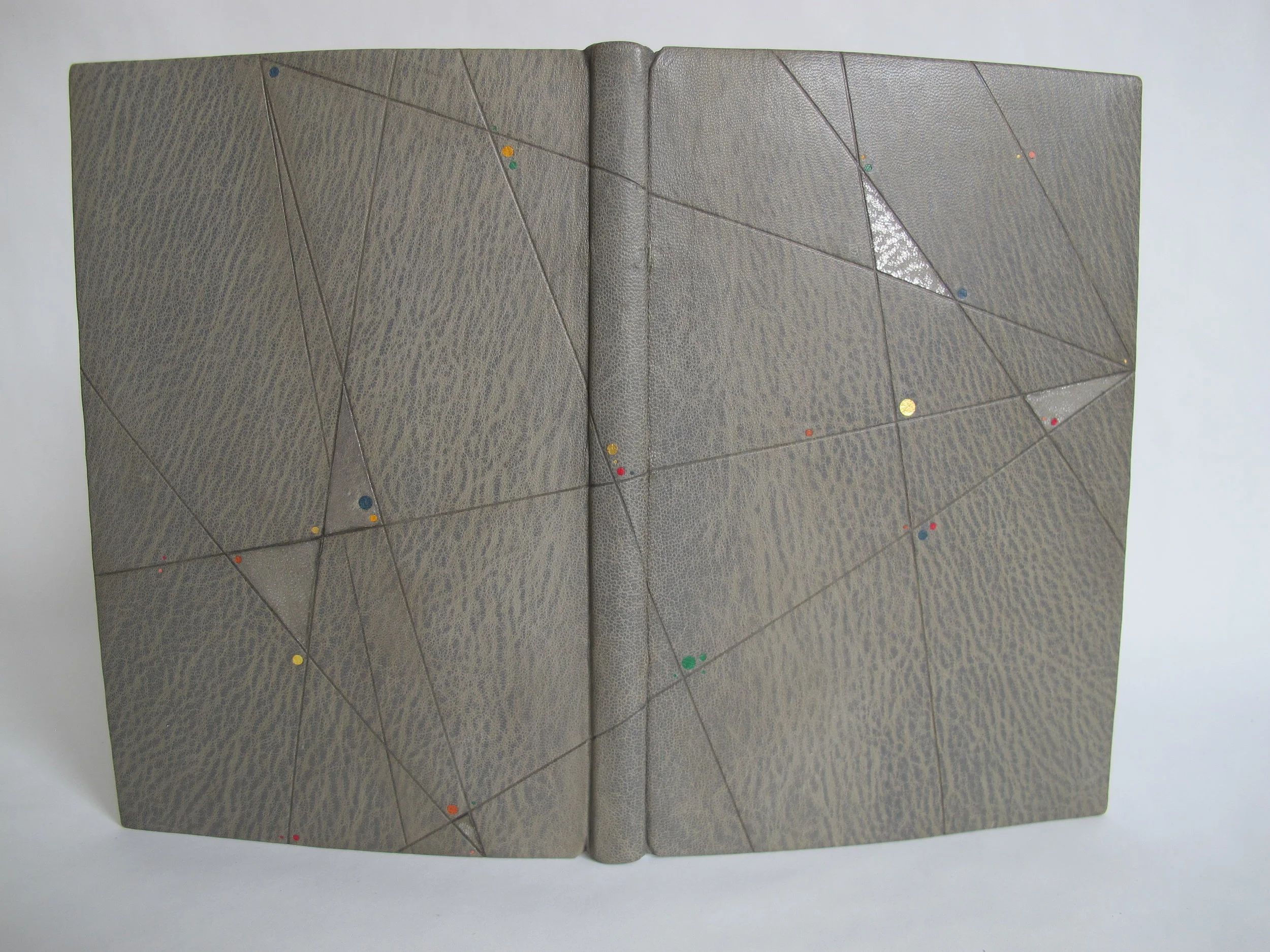
Ghislaine Bureau and Luc Bureau. Published 2017. Bound 2018
240 mm x 160 mm
Grey goatskin, blind tooling, palladium “surface gilt” onlays, inlays of gilt goatskin, dyed goatskin, paper, and wood. Sewn endbands.
A beautiful text about Canada and country with lovely illustrations of Quebec, I wanted to bring to mind maps and road patterns. In this case the lines of the design all lead the readers eyes and hands to open the book on the fore edge of the upper board. The small inlays are easily made using a Japanese screw punch and suggest buildings along the country roads.
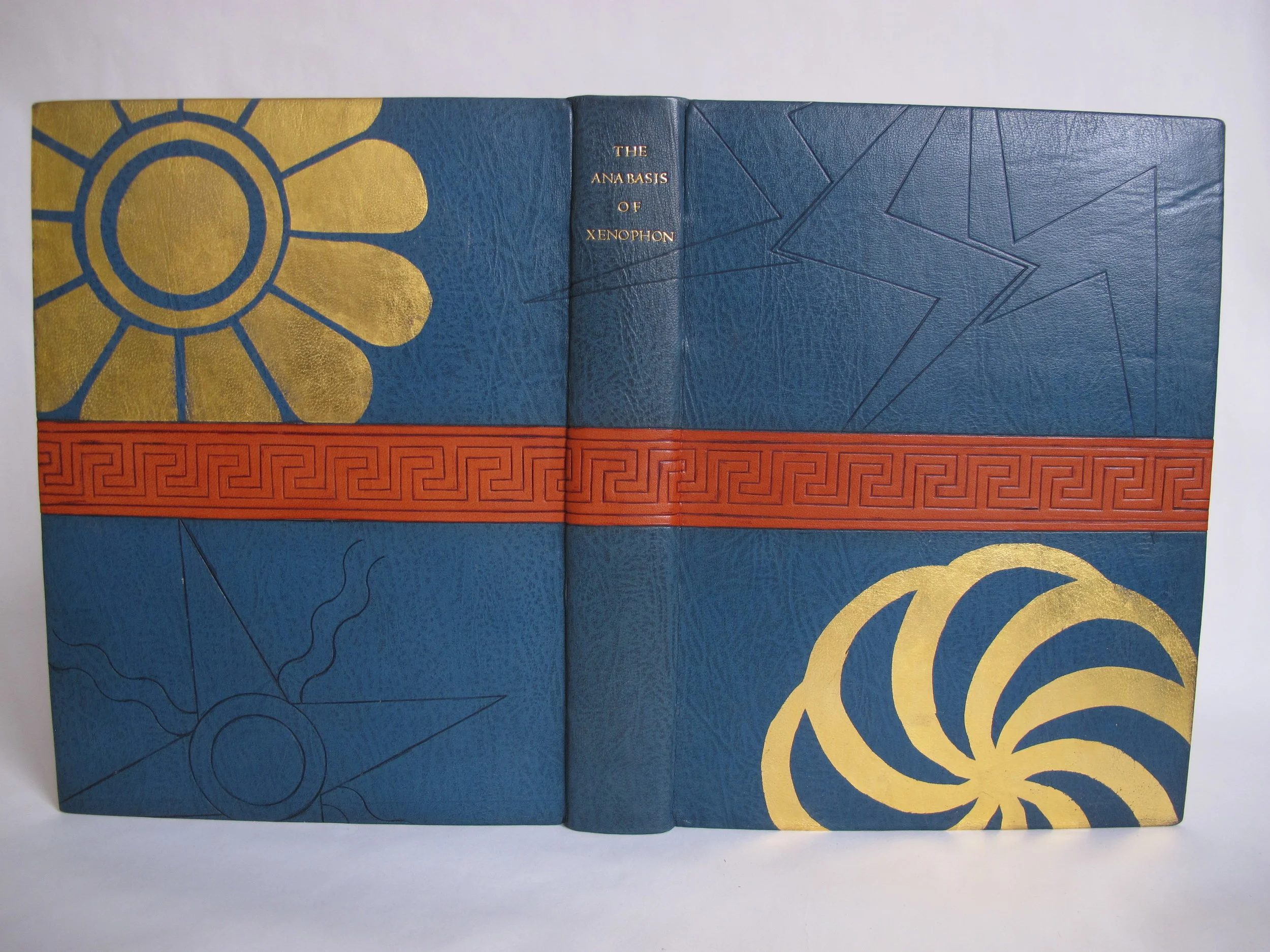

Limited Editions Club, 1969. Rebound 2016.
280 mm x 210 mm
Goatskin, blind tooling, onlay, surface gilding, gold tooling, sewn endbands.
One of the original traveler’s tales, the Anabasis is the story of Xenophon and his army of Greek mercenaries fleeing through Mesopotamia to the Black Sea. On this trip they passed through the lands of several peoples which are represented on this binding by the four symbols tooled and surface gilt on the leather. The center band of terra cotta leather is tooled with a greek key pattern, or meandros, representing Xenophon and his troops passing through these territories.
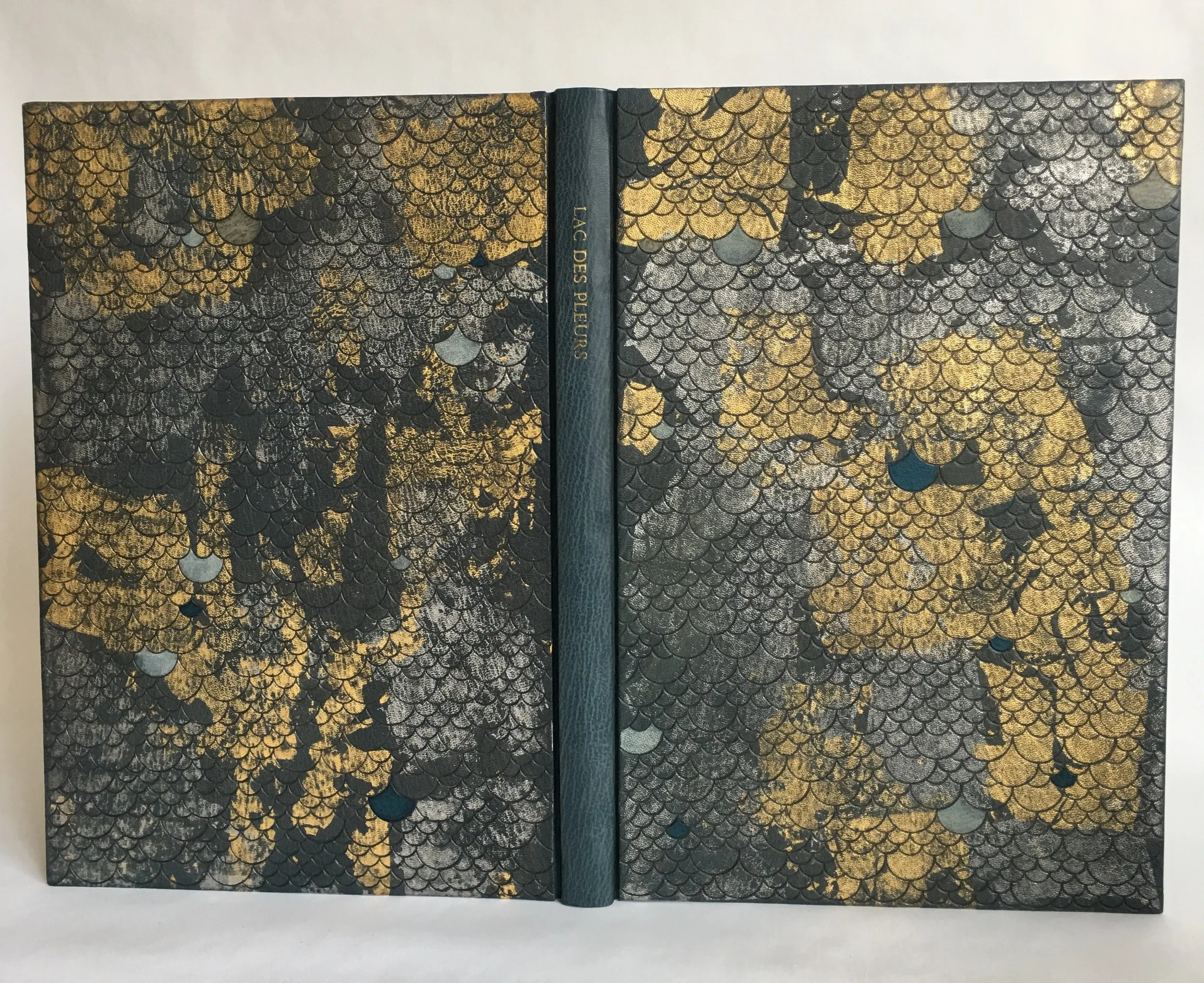


Gaylord Schanilec. Published 2015. Bound 2018.
400 mm x 275 mm
Three part Bradel binding sewn on stubs. Leather from Pergamena, end sheets made of handmade paper by Andrea Petersen of Hook Pottery Paper. End bands of the same material loosely sewn with dyed blue thread. The covers are surface gilt, sanded, polished, blind tooled, scratched, and have tooled-edge onlays. Spine title is foil stamped.
From starting research on the structure to being finished with the box, this book took me over a year to complete. I made several model books to make sure the binding was appropriate and suitable for a masterpiece of modern printing. I kept detailed notes on how this book was made in a 1:1 copy of the book using the same kinds of paper which is kept in a separate (much larger) box with plaquettes, the aforementioned models, the tooling template for the covers, and material samples. The cover is intended to evoke the shimmering of the surface of water, fish scales, and waves. This binding uses two different techniques I come back to regularly: large scale surface gilding and detailed repetitive tooling. The rough surface gilding lends in this case depth, and the tooling lends texture. I have admired Gaylord’s work for years, and it was a daunting pleasure to be able to bind one of his works.
More details about this binding can be seen under the “Featured” tab of this site.


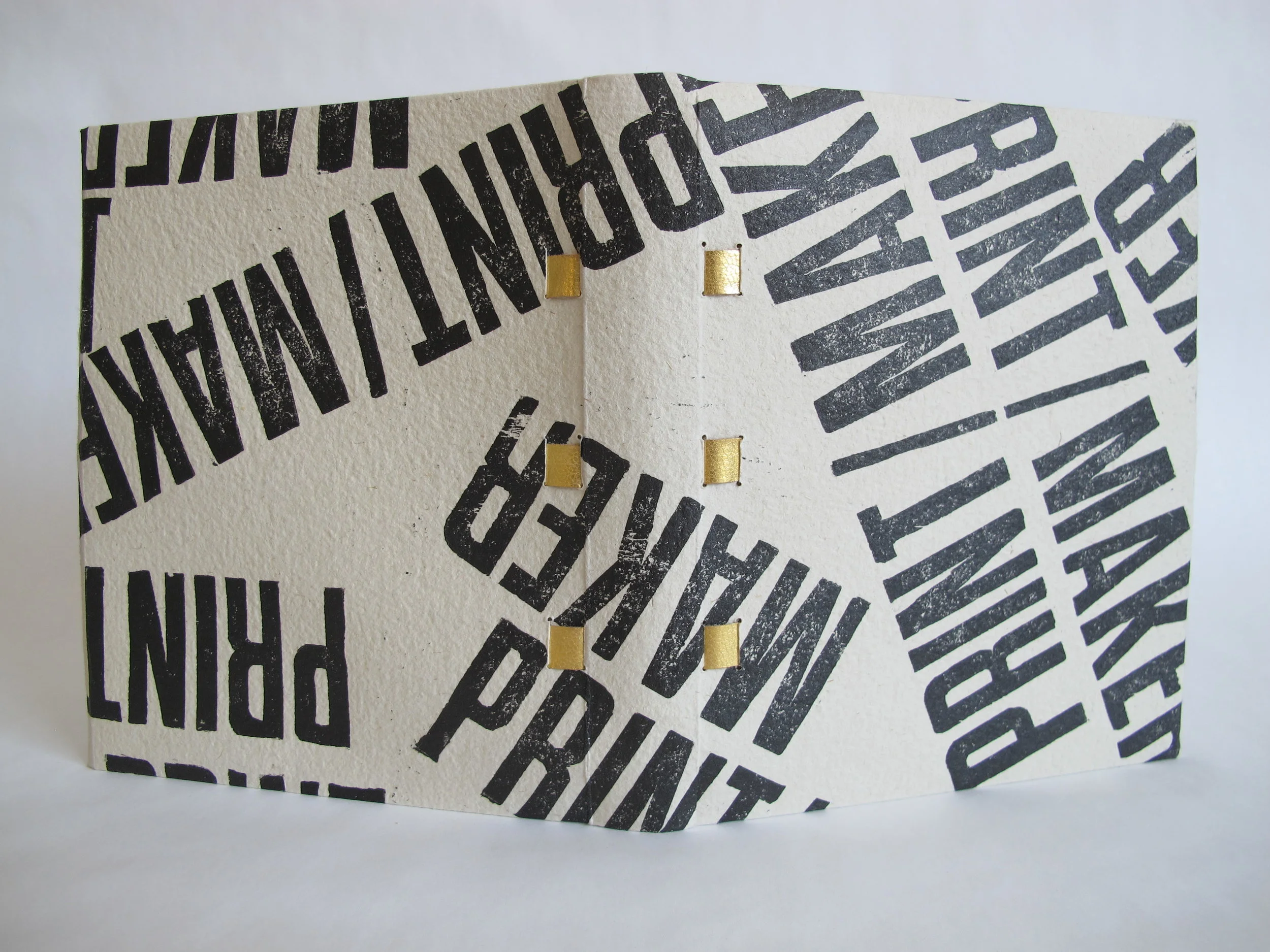
UPPERCASE Encyclopedia of Inspiration. Bound 2019.
215 mm x 165 mm
Relief printing, surface gilt leather sewing supports, sewn endbands
Bound as part of UPPERCASE magazine’s Encyclopedia of Inspiration series, this book is a tour of many print makers and their shops. This is a simple paper structure and an opportunity I used to resuscitate my old relief carving and printing skills. While more a showcase of my poor printing abilities than my good binding skills, it is still a satisfying binding to hold and use.



William Blake. Printed by Russel Maret 2018. Bound 2019.
230 mm x 170mm
Parchment, alcohol transfer, sewn linen reverse bead endbands, ribbon.
Bound for the American Academy of Bookbinding’s Open Set comptetion, binders were invited to work inside the book as well as the outside. As this is a letter from Blake to his patron Thomas Butts about how he's too busy with other work, I decided to take a similar approach. Since we were provided the text block far in advance, I separated the folios and laid them out on my bench. For the next eight months I worked on top of them, making marks and cutting as I normally would. They also changed color from the sun streaming in through my studio windows. The text became a reflection of eight months of my work, as well as how poorly I treat my working surface.
For the binding I wanted to stay with that theme and not labor over it too much. I settled on a simple parchment binding that could be sewn fairly quickly. For the images on the cover I took images from some of William Blake's notebooks and transferred them onto the parchment using alcohol. The ribbons and the thread of the exposed sewing are a pleasant green, reflecting some of the color that ended up on the inside of the text from my months of work.



Eugene Guillevic and Julius Baltazar. Published by Alain Piroir 1990. Bound 2018.
115 mm x 165 mm
Teal dyed calfskin with scratches, water resists, alcohol drops, and craquelé Leather endbands.
Bound for the 2020 Open Set Competition by the American Academy of Bookbinding, I was entranced by the deep blues of Baltazar's prints in this book and attempted to recreate that wild, moving, textured imagery on the cover. I chose calfskin because of the tight, light grain and specifically because it shows marks so well. The bands on the spine are a nod to the supports the book is sewn on as well as a way to accent the rest of the binding. This book received a “Highly Commendable” award for leather treatment from the judges.